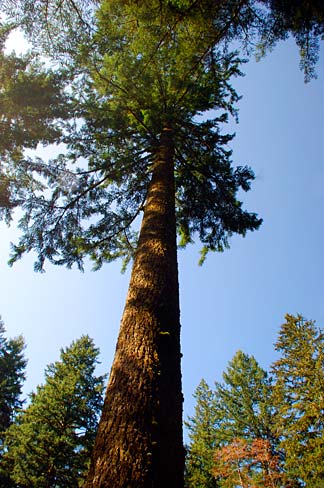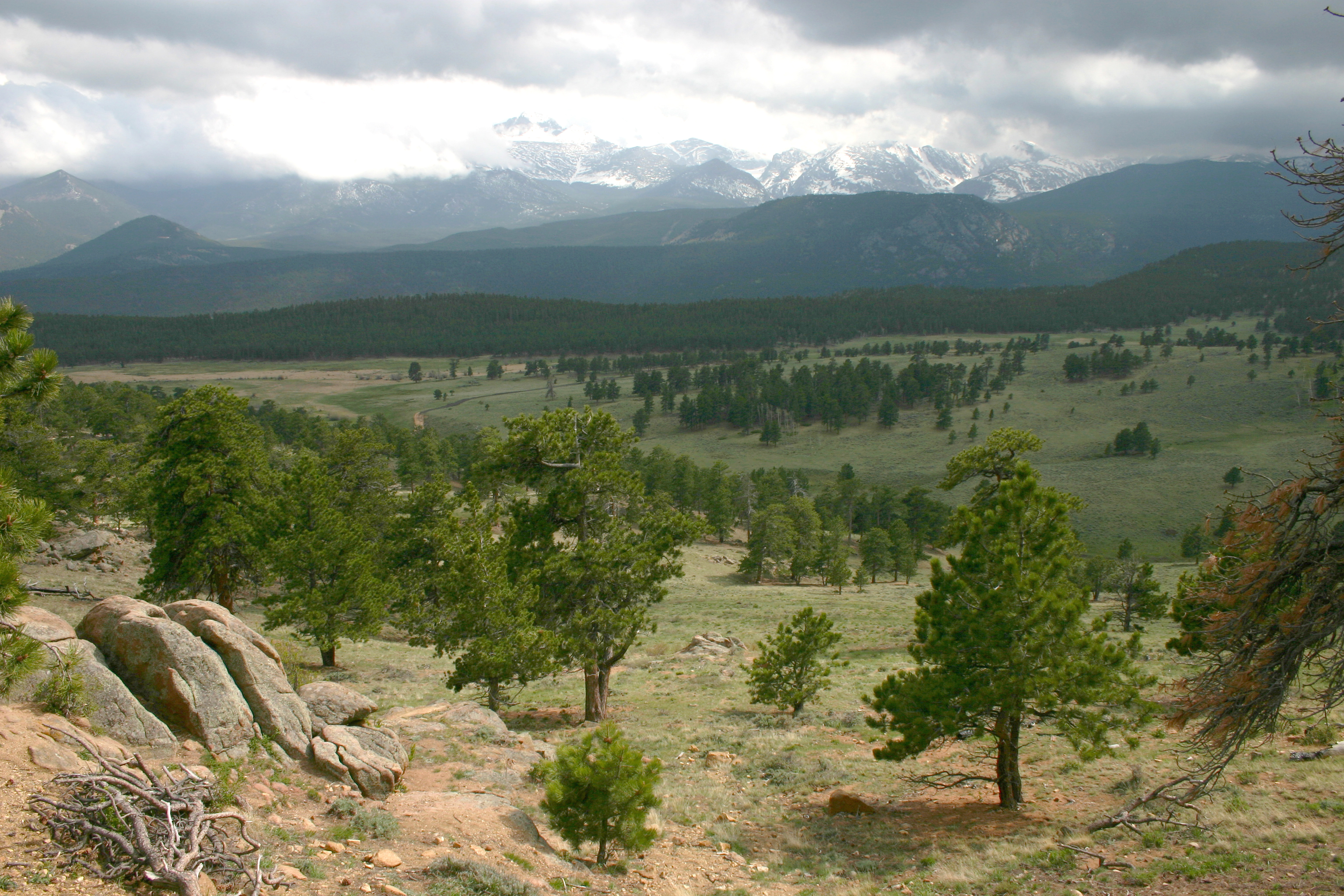May 9, 2015
| Original link: http://blogs.scientificamerican.com/artful-amoeba/2015/05/09/dying-trees-can-send-food-to-neighbors-of-different-species/?WT.mc_id=SA_Facebook

No tree stands alone. Douglas-fir at Silver Falls State Park by Gary Halvorson, Oregon State Archives. Click image for source and license.
No tree is an island, and no place is this truer than the forest. Hidden beneath the soil of the forest understory is a labyrinth of fungal connections between tree roots that scientists call the mycorrhizal network. Others have called it the wood-wide web.
The connections are made by the filaments of fungi that grow in and around plant roots and produce many of the forest mushrooms we know and love. They bond trees so intimately that the more you learn about them, the more it is a struggle to view any tree as an individual. Forest trees and their root fungi are more or less a commune in which they share resources in a fashion so unabashedly socialist that I hesitate to describe it in detail lest conservatives reading this go out and immediately set light to the nearest copse.
This story stars two trees. They are the interior douglas-fir and the ponderosa pine — hearty and prolific trees that grow over large spans of the American west. The ponderosa pine is my favorite conifer and maybe also my favorite tree. Its forests are full of air and light; its bark smells like butterscotch or vanilla when warmed by the sun.

Open ponderosa pine forest at one of my favorite places in the world — Rocky Mountain National Park, Colorado.
Playing a bit part is a humble, unassuming fungus: Rhizopogon. It would compete in “Potato Class” at the state fair’s produce beauty contest. Here is Rhizopogon rubescens.
“Rhizopogon rubescens“. Licensed under CC BY-SA 2.5 via Wikimedia Commons.
Unlike many mycorrhizal fungi, which produce colorful and beautiful gilled or pored mushrooms at the surface, Rhizopogon makes what is called a “false truffle” — an underground spore-making body. Rhizopogon does start to peep through the surface litter, however, as it nears ripeness, as you can see above.
Like all truffles they make their living by enticing mammals with an irresistible smell to dig them up and eat them. The mammals’ digestive systems, fidgety personalities (in the American west, squirrels are often the mammals in question), and the call of nature do the rest. Many, many distantly related fungi have evolved to do this separately; it seems to be an adaptation favored in dry climates where low-humidities make traditional moist breeze-based spore dispersal methods less effective. Rhizopogon seems to have evolved from above-ground pore-bearing mushrooms called boletes.
The spores are produced in the many contortions inside the “fruiting body”, as you can see below. Click through to the original to magnify and appreciate the intricacy of this biological lace.
“2010-05-14 Rhizopogon roseolus 2” by Andreas Kunze – Own work. Licensed under CC BY-SA 3.0 via Wikimedia Commons.
Mycorrhizal fungi like Rhizopogon partner with plant roots because each gets something out of it. The fungus infiltrates the plants’ roots. But it does not attack — far from it. The plant makes and delivers food to the fungus; the fungus, in turn, dramatically increases the plant’s water and mineral absorptive powers via its vast network of filaments. They provide far more surface area for absorption than the meager supply of short root hairs the tree could grow alone. What has not been appreciated until relatively recently is both how complex mycorrhizal fungal networks can be and that they can also act as conduits between trees. Much of the work I’m about to describe to you has come out of the laboratory of Professor Suzanne Simard at the University of British Columbia.
For instance, here is a diagram of the mycorrhizal network for a single 30 by 30 meter plot of British Columbian interior douglas-fir forest. It shows only the douglas-fir trees in the plot (green saw-blade looking things, whose size is proportional to tree diameter), and only two species of mycorrhizal fungus. In reality, there would be a few other species of trees and hundreds more kinds of ectomycorrhizal fungi. Hundreds. This is the wood-wide web.
The black dots represent places where scientists drilled into the soil and sampled for the presence of Rhizopogon encasing tree roots. The straight lines indicate which trees’ roots were found in mycorrhiza samples at each location. The lines around the black dots indicate the known extent of each individual fungus; those of the species R. vinicolor are shaded pink and R. vesiculosus are shaded blue. The tree with the black arrow next to it was by far the most well-connected tree; it was linked to 47 other threes through eight individuals of one Rhizopogon species and three individuals of another. Conversely, one Rhizopogon individual linked 19 trees, young and old. If this is but two fungi and one tree species linked by a finite number of sample sites, you can imagine the true complexity when all fungi and all trees are added in.
Water and sugar have already been shown to move from older trees into the mycelial network (they are feeding the fungi, after all), so it’s possible including young trees in the network helps establish them by providing them with food while they are still trying to stand on their own two feet; indeed, this has been demonstrated experimentally before. You can also see what this implies about only cutting the biggest trees in the forest — doing so greatly diminishes the connectedness and hence resilience of the network.
To my surprise, I discovered when researching this post that it has also been known for a while that trees of different species can communicate with and support one another via their mycorrhizae. It’s long been known that plants can communicate with unrelated species through the air; plants getting chomped by herbivores release volatile chemicals that are sensed by neighboring plants, who up their defenses pro-actively just in case. But communicating — and even sharing resources — through mutual root fungi was news to me.
In grasses and other non-woody plants, mycorrhizae have been shown to transmit warnings that plants are being eaten by insects or attacked by pathogens, and to send food or essential nutrients to neighbors of the same or different species. In plants of the same species, mycorrhizae can transmit phosphorous and nitrogen from dying plants to healthy neighbors. Trimming these small plants has also shown that they can send food from stressed out to healthy neighbors. Mycorrhizae may even be used to transmit “piss off” signals by sending toxins to plants competing for resources nearby. But the type of mycorrhizal networks used in these studies of grasses and non-woody plants (arbuscular mycorrhizae) is very different from the ectomycorrhizae that tend to link woody trees.
In trees, Simard and graduate students Brendan Twieg and Leanne Philip found that Douglas-fir seedling and paper birch shuttle carbon back and forth to one another seasonally via their ectomycorrhizae. Paper birch send carbon to Douglas fir seedlings, especially when they were shaded in summer, probably enhancing their survival. In spring and fall, the Douglas-fir return the favor when the birch have no leaves.

Paper birch in Glacier National Park. “Three Betula papyrifera by McDonald Lake” by Wing-Chi Poon – Own work. Licensed under CC BY-SA 2.5 via Wikimedia Commons.
Simard and colleagues also wondered whether mycorrhizae can help trees of different species cope with climate change. Climate change has contributed to bark beetles, blight, and rust epidemics in pine and spruce, while warmer, drier summers have allowed drought and western spruce budworm to denude vast tracts of Douglas-fir. Losing lots of needles for a prolonged time not surprisingly kills trees, but also opens up space for others that may be migrating north in response to climate change.
Such is the case for mass die-offs of douglas-fir, whose death and decay (as well as salvage logging by humans) should make room for ponderosa pines better equipped to tolerate higher temperatures in the same habitat. So scientists wondered: could mycorrhizae facilitate this transition by directly shuttling food from dying douglas-fir to young ponderosa pine? Both species host hundreds of mycorrhizal fungi, of which they share several in common.
Indeed this was what they found in experiments using seedlings planted together in pots which were published in February in the journal Scientific Reports. They used mesh to exclude the roots from interacting directly with one another (roots that come into physical contact “compete” in a way that reduces sharing of resources) but which still allowed mycorrhizal fungi to link the two plants. When they pulled all the needles off the douglas fir seedlings, the battered trees and their root fungi transferred not only food to their ponderosa pine neighbor’s roots and shoots, but also stress signals that stimulated strong synthesis of defensive enzymes in ponderosa pine. That could help the pine prepare for a similar onslaught.
Ectomycorrhizal fungi encasing plant root hairs. This fungus is from a genus called Amanita that is notorious for making poisonous and deadly mushrooms. “Mycorrhizal root tips (amanita)“. Licensed under CC BY 2.5 via Wikimedia Commons.
It wasn’t a trivial amount of food, either. The amount transferred and measured by radioactive carbon labelling was about the same as the energetic cost of reproduction — a significant donation by any standard. They also tested defoliating douglas-fir with western spruce budworm, but their budworms were apparently feeling fussy or not very hungry because they did not eat very much greenery. The scientists believe truly severe insect damage would provoke the same response that their artificial needle-plucking stimulated.
This phenomenon amazes me. On the face of it, it appears as if the douglas-fir is acting altruistically (without expectation of return) to help neighbors of a completely different species in light of its own probable demise. Even without the altruism, that trees as widely unrelated as douglas-fir and ponderosa pine can transfer resources to each other for any reason through fungi from a completely different kingdom is a bit of a shocker to me.
Did the douglas-fir “intentionally” and altruistically send food and defensive signals to the ponderosa pine, or did the fungus act to take them there? It’s possible that it is only passive effect of a source-sink scenario, where the douglas-fir dumped food into its mycorrhizae for safe-keeping in light of severe stress, and the excess resources simply moved from an area of high concentration to an area of low concentration (the growing, resource-hungry ponderosa pine). It’s also possible the douglas-fir is behaving somewhat altruistically and somewhat pragmatically, since exporting carbon to its root network may benefit nearby trees that are close relatives (offspring, even?), and any spillover to trees of completely different species that keeps them healthy may also benefit these same relatives by keeping the forest system as a whole healthy.
It’s also possible the fungus played the more calculated role of a broker with its own interests and “acted to protect its net carbon source,” write the authors, “by allocating carbon and signals to the healthy, more reliable ponderosa pine.” In this way, mycorrhizal fungi may help forests be more resilient to assault in general but especially to those from climate change — whether from drought or pest attacks. In this way, they would help transfer existing, hard-won food resources and insect warning signals from species dying out due to changing climate to species migrating northward into newly vacant habitat and struggling to get a toehold.
References
Beiler K.J., Suzanne W. Simard, Sheri A. Maxwell & Annette M. Kretzer (2009). Architecture of the wood-wide web: Rhizopogon spp. genets link multiple Douglas-fir cohorts, New Phytologist, 185 (2) 543-553. DOI: http://dx.doi.org/10.1111/j.1469-8137.2009.03069.x
Song Y.Y., Suzanne W. Simard, Allan Carroll, William W. Mohn & Ren Sen Zeng (2015). Defoliation of interior Douglas-fir elicits carbon transfer and stress signalling to ponderosa pine neighbors through ectomycorrhizal networks, Scientific Reports, 5 8495. DOI: http://dx.doi.org/10.1038/srep08495
See also:
http://www.botanicalgarden.ubc.ca/potd/2010/03/mycorrhizal_networks.php
